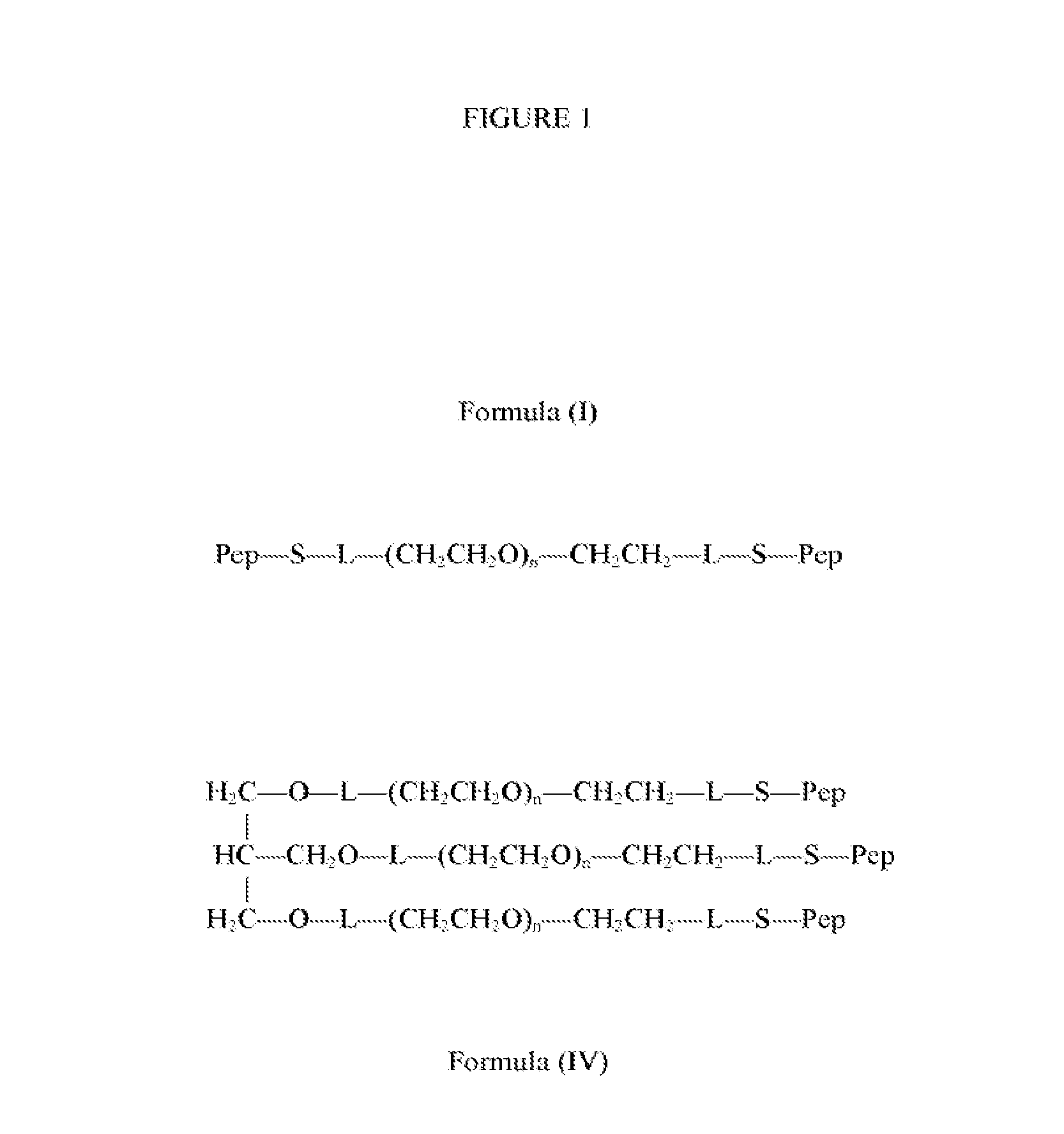Modified peptides and proteins
a technology of peptides and proteins, applied in the field of modified peptides and proteins, can solve the problems of limited bioavailability, undesired immunogenic responses, limited half life of peptides administered as therapeutics, etc., and achieve the effect of enhancing solubility and pharmacokinetic properties
- Summary
- Abstract
- Description
- Claims
- Application Information
AI Technical Summary
Benefits of technology
Problems solved by technology
Method used
Image
Examples
example 1
Synthesis of a Compound of the Formula
[0192]
[0193]To a solution of POEBA [H2N—(CH2CH2O)11—CH2CH2—NH2, 544.67 mg, 1 mmol] in DCM (50 mL) is added 3-(N-maleimidyl)propionyl chloride (2.1 mmol) in DCM (50 mL) at 0° C. under an argon atmosphere with stirring. Triethylamine (5 mmol) is added slowly via syringe, followed by DMAP (0.1 mmol). The mixture is allowed to come to room temperature slowly, and stirring is continued for 8 hours, or until the POEBA is no longer visible by TLC, HPLC, or MS. The mixture is diluted and washed with 1 N HCl (3×50 mL), then washed with saturated aqueous NaHCO3 (3×50 mL), water (3×50 mL), and saturated aqueous sodium chloride (3×50 mL). The organic phase is dried over Na2SO4, filtered, and concentrated. Chromatography through a silica gel column provides the compound, which is analyzed by NMR, IR, MS, and HPLC.
example 2
Synthesis of a Compound of the Formula
[0194]
[0195]To a solution of the product of EXAMPLE 1 (1 mmol) in an aqueous buffer (100 mL) is added the peptide of SEQ ID NO.: 76 (2.1 mmol, 9.66 g) in aqueous buffer (300 mL) at room temperature and pH between 6-10. Prior to addition, the peptide is exposed to a 5-molar excess of dithiothreitol for 30 minutes to reduce and activate the sulfur of the peptide. The mixture is stirred for 24 hours under an argon atmosphere, or until the product of EXAMPLE 1 is no longer visible by TLC, HPLC, or MS. The reaction mixture is concentrated and the product is separated from the excess, unreacted peptide of SEQ ID NO.: 76 by HPLC. The product is analyzed by HPLC and MS.
example 3
Synthesis of a Compound of the Formula
[0196]
[0197]To a solution of POEBA [H2N—(CH2CH2O)11—CH2CH2—NH2, 544.67 mg, 1 mmol] in DCM (50 mL) is added malonyl chloride (2.1 mmol) in DCM (50 mL) at 0° C. under an argon atmosphere with stirring. Triethylamine (10 mmol) is added slowly via syringe, followed by DMAP (0.1 mmol). The mixture is allowed to come to room temperature slowly, and stirring is continued for 24 hours, or until the POEBA is no longer visible by TLC. HPLC, or MS. The mixture is diluted and washed with 1 N HCl (3×50 mL), then washed with saturated aqueous NaHCO3 (3×50 mL), water (3×50 mL), and saturated aqueous sodium chloride (3×50 mL). The organic phase is dried over Na2SO4, filtered, and concentrated to an oil. Chromatography through a silica gel column provides the compound, which is analyzed by NMR, IR, MS, and HPLC.
PUM
| Property | Measurement | Unit |
|---|---|---|
| molecular weight | aaaaa | aaaaa |
| molecular weight | aaaaa | aaaaa |
| molecular weight | aaaaa | aaaaa |
Abstract
Description
Claims
Application Information
 Login to View More
Login to View More - R&D
- Intellectual Property
- Life Sciences
- Materials
- Tech Scout
- Unparalleled Data Quality
- Higher Quality Content
- 60% Fewer Hallucinations
Browse by: Latest US Patents, China's latest patents, Technical Efficacy Thesaurus, Application Domain, Technology Topic, Popular Technical Reports.
© 2025 PatSnap. All rights reserved.Legal|Privacy policy|Modern Slavery Act Transparency Statement|Sitemap|About US| Contact US: help@patsnap.com



